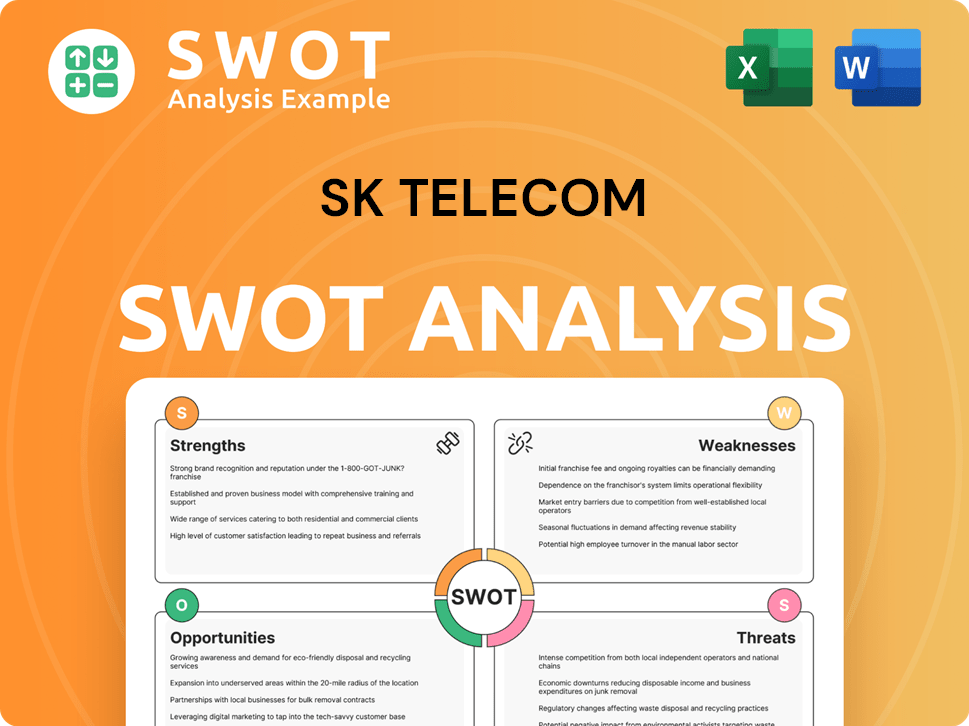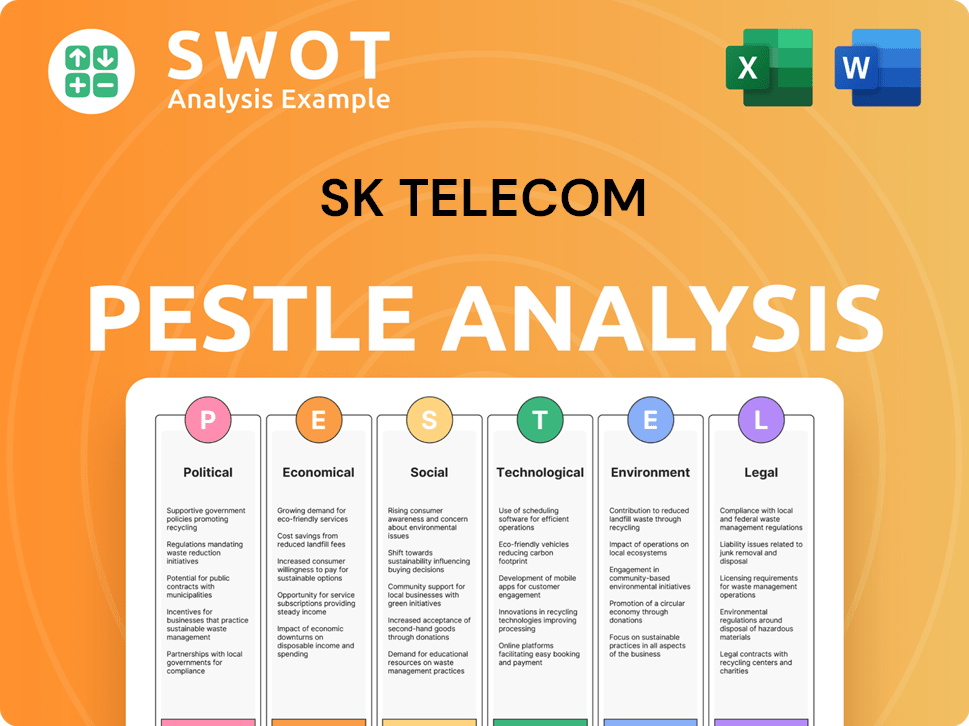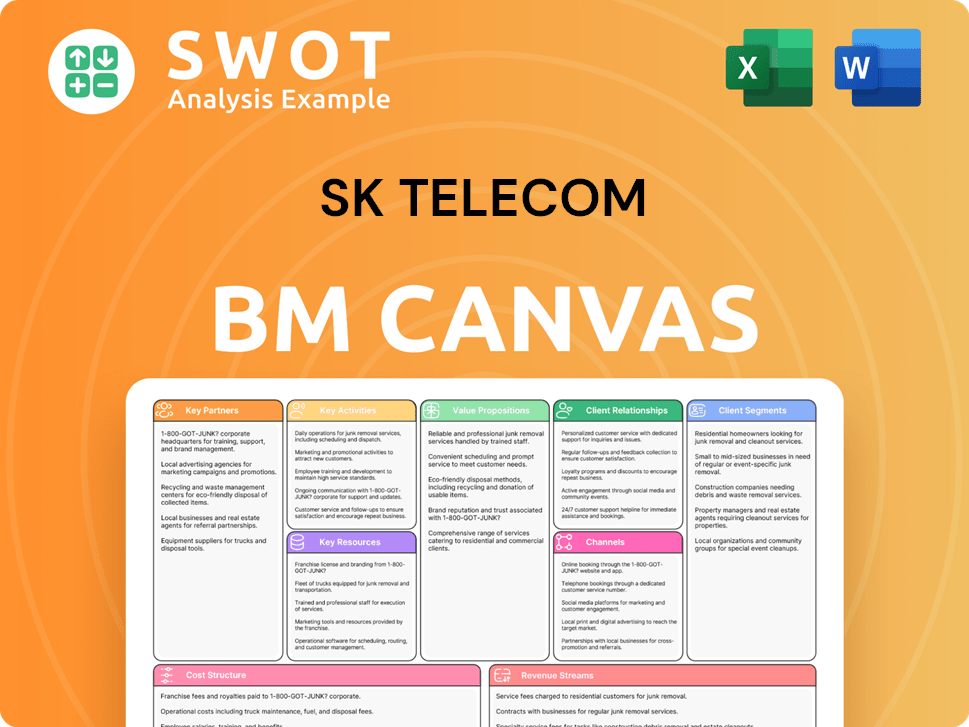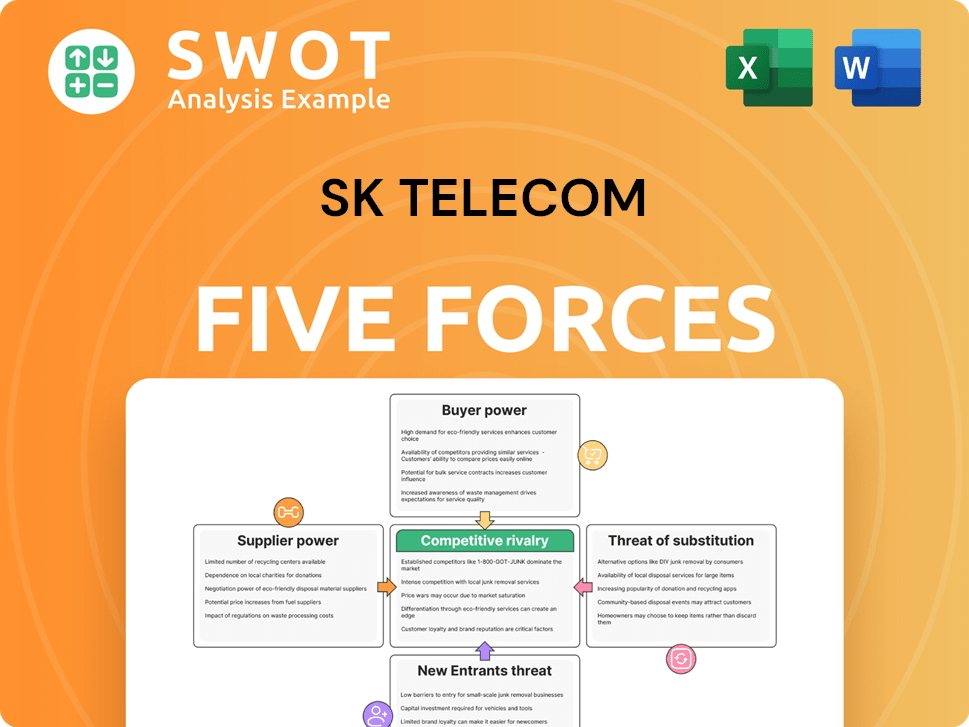SK Telecom Bundle
How Does SK Telecom Dominate the South Korean Telecom Market?
SK Telecom, a titan in South Korea's telecommunications sector, consistently pushes boundaries with its pioneering work in 5G, AI, and the Internet of Things (IoT). As a cornerstone of the SK Group, the company has been pivotal in shaping South Korea's digital infrastructure. This journey, from its inception in 1984 as Korea Mobile Telecommunications Services, showcases a relentless drive for innovation and market leadership.

This exploration of the SK Telecom SWOT Analysis delves into the company's competitive landscape, examining its market positioning and key rivals. We'll dissect its unique advantages, analyzing how SK Telecom navigates the dynamic shifts in the telecommunications industry, and explore its future challenges. Understanding the SK Telecom competitive landscape is crucial for anyone seeking insights into the South Korean telecom market, including SK Telecom competitors and their strategies.
Where Does SK Telecom’ Stand in the Current Market?
SK Telecom holds a leading position in the South Korean telecommunications market, particularly in the mobile communication sector. As of late 2024, it maintained the largest market share in South Korea's mobile subscriber base, consistently around 40% to 50%. This dominance is a key factor in understanding the SK Telecom competitive landscape.
The company's core offerings include mobile communication (5G, LTE), fixed-line telephone, broadband internet (SK Broadband), and a growing portfolio of media services. SK Telecom's geographic presence is primarily focused on South Korea, serving a wide range of customers from individual consumers to large enterprises. Its value proposition centers on providing reliable, high-quality telecommunications services and expanding into innovative ICT solutions.
SK Telecom has evolved from a pure telecommunications provider to a comprehensive ICT company, investing heavily in areas like AI, cloud services, and digital health. This diversification aims to capture new revenue streams and increase customer loyalty. For example, in February 2024, SK Telecom reported approximately 31.4 million mobile subscribers, highlighting its continued strength in the wireless sector. This strategic shift is crucial for its long-term growth and competitive positioning.
SK Telecom consistently leads the South Korean mobile market. Its substantial market share, which has been around 40% to 50%, showcases its strong competitive position. This dominance allows SK Telecom to influence market trends and maintain a loyal customer base. The company's success is a key aspect of any SK Telecom market analysis.
SK Telecom is expanding beyond traditional telecommunications. Investments in AI, cloud services, and digital health are central to its strategy. This diversification helps SK Telecom capture new revenue streams and strengthen customer relationships. This approach is critical for its future outlook.
SK Telecom's financial performance remains robust. The company reported an operating profit of 1.753 trillion won (approximately 1.3 billion USD) for the fiscal year 2024. This financial health provides the resources needed for further expansion and innovation. This financial strength is a key factor in understanding the competitive strategies of SK Telecom.
The company is actively expanding its presence in emerging technology sectors. SK Telecom aims to leverage its existing infrastructure and customer base for future growth. This strategic focus is essential for maintaining its competitive edge in the telecommunications industry.
SK Telecom's strengths include its dominant market share, financial stability, and strategic diversification. These factors contribute to its strong position in the South Korean telecom market. Understanding these strengths is vital for assessing SK Telecom's competitive landscape.
- Market Leadership: Holds the largest mobile subscriber base.
- Diversified Portfolio: Expanding into AI, cloud, and digital health.
- Financial Performance: Strong operating profit in 2024.
- Strategic Vision: Focus on emerging technology sectors.
To understand SK Telecom's long-term strategy, consider the Growth Strategy of SK Telecom, which highlights the company's focus on innovation and expansion. This forward-looking approach is crucial for maintaining its competitive edge in the dynamic telecommunications industry.
SK Telecom SWOT Analysis
- Complete SWOT Breakdown
- Fully Customizable
- Editable in Excel & Word
- Professional Formatting
- Investor-Ready Format

Who Are the Main Competitors Challenging SK Telecom?
The SK Telecom competitive landscape in South Korea is shaped by a dynamic interplay of direct and indirect competitors. The telecommunications industry is highly competitive, with significant investments in 5G infrastructure and service offerings. Understanding the key players and their strategies is crucial for analyzing SK Telecom's market position.
SK Telecom's market analysis reveals a constant battle for market share, particularly in the mobile and broadband sectors. The company faces challenges from established rivals and emerging technology companies. This competitive environment influences SK Telecom's strategic decisions, including pricing, service innovation, and network expansion.
The South Korean telecom market is characterized by intense competition, with each player striving to capture and retain customers. This competition drives innovation and influences the overall development of the telecommunications sector.
SK Telecom's primary direct competitors are KT Corporation and LG Uplus. These companies compete in mobile and broadband services, offering similar core products. They often compete on price, network coverage, and bundled services.
KT Corporation, a major player in the South Korean telecom market, is a significant competitor. It has a strong presence in fixed-line services, broadband internet, and mobile communications. KT often focuses on enterprise solutions and leveraging its extensive infrastructure.
LG Uplus has been aggressively expanding its 5G network and content offerings. It challenges SK Telecom on price and innovative service bundles. LG Uplus has invested heavily in exclusive content partnerships to attract subscribers.
Indirect competition comes from global technology giants in cloud services, content streaming, and AI solutions. Emerging players in niche technology areas, such as specialized IoT providers or AI startups, also present potential disruptions.
Each competitor employs distinct strategies to gain market share. LG Uplus focuses on exclusive content, while KT emphasizes B2B solutions. All three major players offer competitive plans and device subsidies, particularly in the 5G subscriber acquisition race.
Mergers and alliances could significantly alter competitive dynamics, although they are less frequent among major telcos in South Korea. The constant evolution of technology and consumer preferences further shapes the competitive landscape.
The SK Telecom competitors operate in a market where technological advancements and regulatory changes constantly reshape the landscape. For instance, the deployment of 5G has been a key battleground, with each company investing heavily in infrastructure and marketing. The Target Market of SK Telecom provides insights into the company's customer base and how it positions itself in this competitive environment.
Several factors contribute to the competitive intensity in the South Korean telecom market. These include network quality, pricing strategies, service offerings, and technological innovation. The ability to attract and retain customers depends on these factors.
- Network Coverage and Quality: Ensuring robust and reliable network infrastructure is crucial for attracting and retaining customers.
- Pricing and Bundled Services: Competitive pricing and attractive service bundles are essential to gain market share.
- Technological Innovation: Embracing new technologies like 5G and AI to enhance services and customer experience.
- Customer Service: Providing excellent customer service to build brand loyalty and differentiate from competitors.
SK Telecom PESTLE Analysis
- Covers All 6 PESTLE Categories
- No Research Needed – Save Hours of Work
- Built by Experts, Trusted by Consultants
- Instant Download, Ready to Use
- 100% Editable, Fully Customizable

What Gives SK Telecom a Competitive Edge Over Its Rivals?
The competitive advantages of SK Telecom (SKT) are rooted in its strong network infrastructure, extensive customer base, and a proactive approach to technological innovation. The company has a significant edge due to its proprietary 5G technology, which it has rapidly deployed across South Korea, offering superior speeds and connectivity. This advanced network capability is a key differentiator, especially as 5G adoption continues to grow within the telecommunications industry.
SKT's brand equity and customer loyalty, cultivated over decades, provide a substantial advantage. This is supported by a vast distribution network, including numerous retail stores and online channels, ensuring broad accessibility for its services. Furthermore, the company benefits from economies of scale as the largest mobile operator, which allows for more efficient network operations and procurement. The company's strategic investments in areas like AI and digital health are creating new competitive advantages, enhancing customer experience and driving new revenue streams.
These advantages have evolved from providing mobile connectivity to offering a holistic digital lifestyle, leveraging its strong market position to diversify into new growth areas. However, these strengths face challenges from rapid technological shifts and aggressive competitor strategies, necessitating continuous innovation and adaptation. To better understand the company's journey, you can explore a brief history of SK Telecom.
SKT's robust network infrastructure, including its advanced 5G technology, provides superior speeds and connectivity. This technological advantage is crucial for emerging applications like smart cities and autonomous vehicles. The company's extensive deployment of 5G across South Korea gives it a significant edge in the telecommunications industry.
SKT benefits from a large and loyal customer base built over years of reliable service. This strong brand equity is reinforced by an extensive distribution network, ensuring broad accessibility for its services. The company's reputation for quality enhances customer loyalty and market position.
SKT's proactive approach to technological innovation, including its investments in AI and quantum cryptography, sets it apart. The company has many patents related to network architecture and mobile technologies. This focus enables the development of new services and revenue streams.
As the largest mobile operator, SKT benefits from economies of scale, enhancing operational efficiency. This allows for more effective network operations and procurement processes. These efficiencies support its competitive position in the South Korean telecom market.
SK Telecom's competitive edge stems from its advanced 5G network, strong brand, and strategic investments in emerging technologies. These factors enable it to differentiate itself in the competitive landscape and maintain a strong market position. The company's focus on customer experience and innovative services further strengthens its advantage.
- Advanced 5G Network: Rapid deployment and superior speeds.
- Strong Brand Equity: Reputation for reliability and quality.
- Strategic Investments: Focus on AI, digital health, and other new technologies.
- Extensive Distribution Network: Wide accessibility for services.
SK Telecom Business Model Canvas
- Complete 9-Block Business Model Canvas
- Effortlessly Communicate Your Business Strategy
- Investor-Ready BMC Format
- 100% Editable and Customizable
- Clear and Structured Layout

What Industry Trends Are Reshaping SK Telecom’s Competitive Landscape?
The telecommunications sector is experiencing rapid transformation, driven by 5G expansion, AI integration, and the growth of the Internet of Things. This dynamic environment presents both opportunities and risks for companies like SK Telecom. Understanding the SK Telecom competitive landscape is crucial for strategic planning and sustained market success.
The SK Telecom industry position is evolving, marked by significant investments in 5G infrastructure and a strategic shift towards AI and digital services. Regulatory changes and the saturation of the domestic mobile market pose challenges, while opportunities in emerging technologies and strategic partnerships offer pathways for growth. The company's future outlook depends on its ability to adapt and innovate within this competitive environment.
Key trends include the continued rollout of 5G, the integration of AI, the expansion of IoT, and the demand for enterprise solutions. 5G is enabling new revenue streams through enhanced mobile broadband and ultra-reliable low-latency communication. AI is being leveraged to revolutionize various industries, and IoT is expanding the scope of connectivity and data-driven services.
Challenges include the high capital expenditure required for 5G upgrades and the development of 6G. The domestic mobile market saturation necessitates diversification into new growth areas. Regulatory changes concerning data privacy and network neutrality also pose potential hurdles. Competition from other SK Telecom competitors in the South Korean telecom market remains intense.
Significant opportunities lie in AI-powered platforms and services, the metaverse, digital health, and enterprise solutions. Strategic partnerships with global technology companies and startups are crucial for accelerating innovation. Expanding into new markets and services can help the company enhance its SK Telecom market analysis and overall financial performance.
SK Telecom is focusing on AI, with platforms and services aimed at revolutionizing various industries. The company is also expanding its presence in the metaverse, digital health, and enterprise solutions. Strategic partnerships are essential for accelerating innovation and market penetration in these emerging areas. To learn more about this, check out the Marketing Strategy of SK Telecom.
The telecommunications industry is dynamic, with 5G, AI, and IoT driving change. SK Telecom faces challenges such as high capital expenditures and market saturation but has opportunities in AI, metaverse, and enterprise solutions. Strategic initiatives and partnerships are key to future success. The company's future outlook is positive with the right strategies.
- Diversification into new growth areas is crucial.
- Strategic partnerships are vital for innovation and market expansion.
- Focus on AI and digital services to drive future growth.
- Adaptation to regulatory changes is essential for long-term sustainability.
SK Telecom Porter's Five Forces Analysis
- Covers All 5 Competitive Forces in Detail
- Structured for Consultants, Students, and Founders
- 100% Editable in Microsoft Word & Excel
- Instant Digital Download – Use Immediately
- Compatible with Mac & PC – Fully Unlocked

Related Blogs
- What are Mission Vision & Core Values of SK Telecom Company?
- What is Growth Strategy and Future Prospects of SK Telecom Company?
- How Does SK Telecom Company Work?
- What is Sales and Marketing Strategy of SK Telecom Company?
- What is Brief History of SK Telecom Company?
- Who Owns SK Telecom Company?
- What is Customer Demographics and Target Market of SK Telecom Company?
Disclaimer
All information, articles, and product details provided on this website are for general informational and educational purposes only. We do not claim any ownership over, nor do we intend to infringe upon, any trademarks, copyrights, logos, brand names, or other intellectual property mentioned or depicted on this site. Such intellectual property remains the property of its respective owners, and any references here are made solely for identification or informational purposes, without implying any affiliation, endorsement, or partnership.
We make no representations or warranties, express or implied, regarding the accuracy, completeness, or suitability of any content or products presented. Nothing on this website should be construed as legal, tax, investment, financial, medical, or other professional advice. In addition, no part of this site—including articles or product references—constitutes a solicitation, recommendation, endorsement, advertisement, or offer to buy or sell any securities, franchises, or other financial instruments, particularly in jurisdictions where such activity would be unlawful.
All content is of a general nature and may not address the specific circumstances of any individual or entity. It is not a substitute for professional advice or services. Any actions you take based on the information provided here are strictly at your own risk. You accept full responsibility for any decisions or outcomes arising from your use of this website and agree to release us from any liability in connection with your use of, or reliance upon, the content or products found herein.